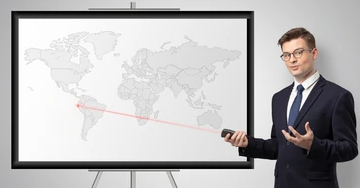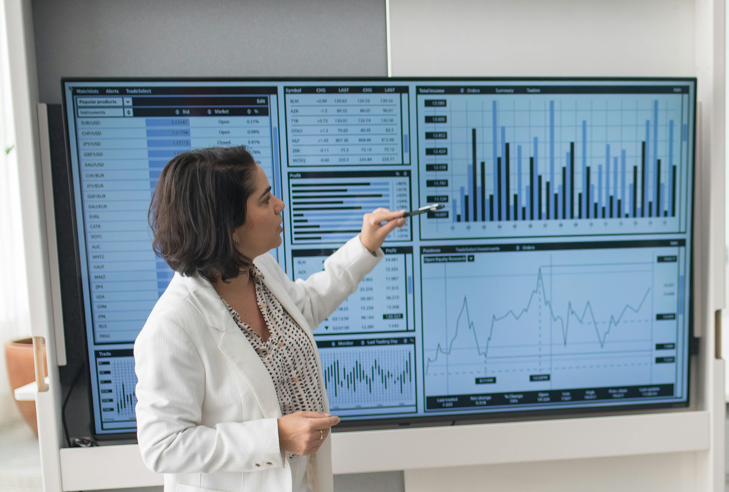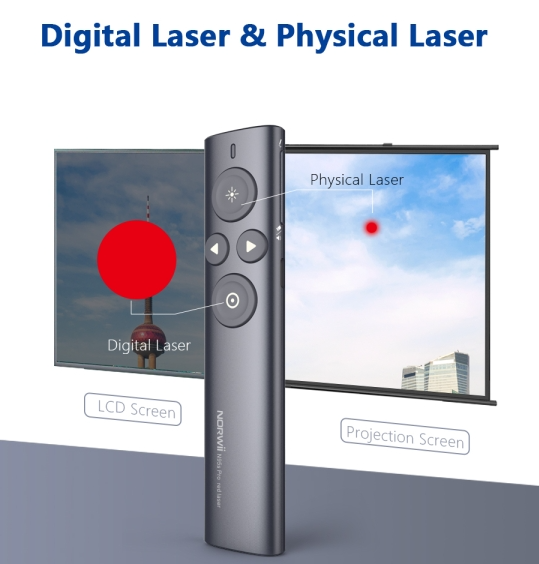Traditional laser pointers don’t work on LED screens due to the non-reflective nature of LED displays, their high brightness, and the small size of their pixels. However, there are some clever alternatives that can be used.
Laser pointers have become an essential tool for presenters, educators, and professionals who need to highlight specific points during their presentations. The reason they have become so important is because we know that using a pointer to get your audience to focus on a specific point on screen helps to get them to focus and improves retention of information. However, one frustrating issue that many encounter is the fact that traditional laser pointers are not visible when used with LED screens. Some suppliers will tell you their laser pointers work because they are green or are extra bright but regardless of what they say, I can tell you that even the best laser pointers struggle on LED screens. I will explain a bit more why this is and give you an alternative.
What Do Laser Pointers Do

Laser pointers emit a focused beam of light that is visible to the human eye. This light is typically in the red or green spectrum and is usually powerful enough to be seen from a distance, making it ideal for pointing out details on a projection screen or a whiteboard. The primary function of a laser pointer is to project this concentrated light onto a surface, where it creates a small, bright spot that draws attention.
Why are LED Screens Different to Traditional Screens
LED (Light Emitting Diode) screens, on the other hand, are a completely different technology. These screens are made up of millions of tiny light-emitting diodes that work together to produce images and video. Each pixel on an LED screen is a small light source that can change color and brightness independently. The surface of an LED screen is not reflective like traditional projection screens or whiteboards; instead, it is designed to emit light directly to the viewer.
Why Don’t Laser Pointers Work on LED Screens
The core reason laser pointers do not work on LED screens lies in the nature of how light interacts with these screens. Here are the main points:
- Non-reflective Surface: LED screens are designed to emit light rather than reflect it. When the laser pointer’s beam hits the surface of an LED screen, there is no reflective layer to bounce the light back to the viewer’s eyes. Instead, the light from the laser is absorbed or scattered by the surface.
- Brightness of LED Screens: LED screens are often very bright, especially in well-lit environments. The light emitted by the screen can overwhelm the relatively small and dim light spot produced by a traditional laser pointer. This makes the laser spot nearly invisible against the bright backdrop of the LED display.
- Pixel Density and Size: The high pixel density of LED screens means that the individual pixels are very small. A laser pointer typically produces a spot that covers multiple pixels, which can diffuse the laser light and make it harder to see. Additionally, if the screen resolution is very high, the laser spot might not stand out at all.
So regardless of what online suppliers tell you about the range or brightness of their laser pointer, the chances are that whatever laser pointer you buy it won’t work on most TV or LED display screens. This means if you want to use a pointer when presenting on an LED screen you are going to need an alternative.
What Alternatives Work on LED Screens
There are actually several alternative pointers that can be effectively used on LED screens.
Use your mouse – One popular option is the use of software-based pointers, which are integrated into presentation software such as Microsoft PowerPoint or Google Slides. These allow presenters to use their mouse or a stylus to highlight or annotate directly on the screen. The downside to this type is that you usually need to present next to a table or lectern so you can move your mouse on a flat surface.
Digital Pointers – Another alternative is the use of presentation remotes with built-in digital pointers, which can create visible pointers on LED displays. Interactive whiteboards and touchscreens also offer robust options, enabling users to draw or highlight directly on the display surface using a finger or stylus.
AR Pointers – Lastly, augmented reality (AR) pointers, which utilize devices like smartphones or AR glasses to project virtual pointers onto the screen, are emerging as innovative solutions for modern presentations but these are still quite new.
I have tested almost all of these types and my favourite option is to use a “Digital Pointer”, unlike laser pointers these don’t have an actual laser light but display a pointer digitally and my favourite one is the Norwii N95 Pro.
Norwii N95 Pro Digital Laser: A Solution for LED Screens
Understanding the limitations of traditional laser pointers with LED screens has led to the development of advanced presentation tools like the Norwii N95 Pro digital laser pointer. This device is specifically designed to work with modern display technologies, including LED screens.
Features of the Norwii N95 Pro
The Norwii N95 Pro is equipped with several features that make it an ideal tool for presentations involving LED screens:
- Digital Laser Technology: Unlike traditional laser pointers that rely on a beam of light, the Norwii N95 Pro uses digital laser technology. This technology creates a digital highlight on the screen, which is more visible and effective on LED displays.
- Multi-functional Pointer: The N95 Pro allows users to switch between different pointer modes, including a digital laser, spotlight, and magnifier. This versatility ensures that the pointer can be seen clearly on any type of screen, including LED, LCD, and even projection screens.
- Adjustable Brightness and Size: The digital pointer’s brightness and size can be adjusted to match the ambient light conditions and the screen’s brightness. This feature ensures that the pointer remains visible regardless of the environment.
- Compatibility with Presentation Software: The N95 Pro integrates seamlessly with popular presentation software like Microsoft PowerPoint, Google Slides, and Prezi. This integration allows for smooth transitions and animations, enhancing the overall presentation experience.
- Wireless Connectivity: The Norwii N95 Pro connects to your computer wirelessly, offering a range of up to 100 meters. This flexibility allows presenters to move freely around the room without being tethered to their computers.
Why the Norwii N95 Pro Works on LED Screens
The key to the Norwii N95 Pro’s effectiveness on LED screens lies in its use of digital laser technology. Instead of relying on a physical beam of light, the device generates a digital signal that interacts with the display’s pixels. This signal is processed by the screen, which then highlights the pointer in a way that is easily visible to the audience. This method bypasses the reflective and brightness issues that plague traditional laser pointers.
Additionally, the ability to adjust the pointer’s brightness ensures that it remains visible even on the brightest LED screens. By tailoring the pointer’s intensity to the screen’s light output, the Norwii N95 Pro ensures that the highlight stands out clearly.
Conclusion
If you present in different venues or if you always present on an LED screen and you don’t want to have to use your finger all the time to highlight something on screen then then you will need to get yourself either a Digital Pointer like the Norwii N95 Pro or a use a mouse but this will mean that you need to present behind a table. Digital pointers are the most flexible as they can be used on any format and in any circumstances, investing in a device like the Norwii N95 Pro is a wise choice. They are not too expensive and will really help you to look more professional in any situation. to a more effective and professional presentation.
If you have found any other solutions for pointing at LED screens let me know in the comments below
Pete




Thanks for a very informative blog,this is the only place I could get this kind
of information written in such an ideal approach?
I’ve a challenge that I am just now operating on, and I’ve been on the look out for such information.
Hi Becky,
Thanks for your feedback and really glad to hear that you found it useful. I spent ages trying to find this information too so that is why I wrote this blog.
Pete
This article is packed with great information and is very helpful.
The website is an excellent resource for learning.
Hi Kazuko,
Thanks for the feedback and I am really glad that you liked the post, I was getting really frustrated with the many laser pointers that i had tried and everyone kept saying that green ones would be ok. I now know this is completely not true so decided to share this and hopefully save others some time and money in their search for a system that does work.
Pete
Howdy! Do you use Twitter? I’d like to follow you if that would be ok.
I’m definitely enjoying your blog and look forward to new updates.
Hi Sam,
Thanks for the feedback, I am on Twitter and other socials but haven’t posted much on them previously. I plan to start posting some content on them in the next few months though so feel free to follow and it would be very much appreciated.
Twitter
Facebook
Instagram
LinkedIn